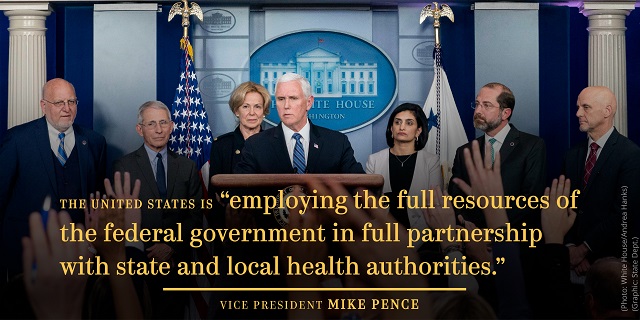The U.S. has deployed a “whole-of-America approach” to protect citizens against the coronavirus, with federal, state and local governments, as well as private businesses, banding together to fight the disease, Vice President Pence said.
President Trump on March 6 signed into law $8.3 billion in federal funding to bolster federal and state governments’ collaborative approach to fighting COVID-19. The measure provides funding for vaccines, tests and potential treatments, as well as other response efforts.
“We’ll continue to bring the full resources of … every agency of this government to address this crisis,” Pence said March 4.
Federal agencies are leading all levels of government in responding to the disease, while governors of the states most affected, including California and Washington, are implementing strong new protections for health care workers and others.
Pence said the Trump administration has taken unprecedented steps to speed the availability of testing and improve screening. And in meetings with industry, Trump and Pence are rallying an already strong private-sector response to the disease.

Here are just a few examples of the “whole-of-America approach” referred to by the vice president:
- Federal agencies: The U.S. Department of Health and Human Services and the Centers for Disease Control and Prevention have funneled millions of dollars to state and local governments. The agencies forwarded an initial $25 million to the hardest-hit jurisdictions for medical supplies, lab equipment, increased staffing and other protective measures. An additional $10 million in federal funding is helping state and local governments nationwide to detect new cases. “State and local governments are the backbone of our public health system,” HHS Secretary Alex Azar said March 4.
- State and local governments: States facing the most coronavirus cases have declared states of emergency, allowing officials to implement strong public health protections. California’s declaration protects consumers against steep price hikes on food, gas and other essential supplies and allows health care workers to come from out of state to assist. Washington state officials have ensured workers compensation coverage for all health care workers. “These health care workers and first responders are protecting our communities,” Governor Jay Inslee said March 5. “They need to know that we have their backs.”

- Private businesses: Medical supply companies are ramping up production of protective equipment at home and abroad. For example, 3M Co. is quickly increasing production of respirators and other supplies at its facilities in the United States, Asia and Europe. At a meeting of diagnostic laboratory business leaders, Pence said, “This is a powerful industry and we know working with you that, literally, we can make thousands of tests available within a week to the American public and literally — literally millions of tests available in the weeks ahead.”
- Colleges and universities: U.S. educational institutions are also helping track and detect the disease. Johns Hopkins University has developed an online tracking system for cases worldwide, while some university laboratories are conducting testing, Pence said.
- Helping other nations: Working together, the U.S. government, private companies and other U.S. donors have already shipped 17 tons of donated supplies, including respirators, masks and other medical supplies to help the Chinese people.
The federal government has so far set aside up to $100 million to assist China and other countries suffering from the coronavirus. “The United States is and will remain the world’s most generous donor,” U.S. Secretary of State Mike Pompeo said last month. The secretary said the U.S. response is “serious, robust and will continue to be.”







COMMENTS3
Wonderful post! Keep up the good writing. Thanks for sharing with us!
I would sincerely express my thanks to the writer for bringing something to the online world which is completely new.
Useful Information Thank you for sharing this post.
LEAVE A COMMENT
TOP